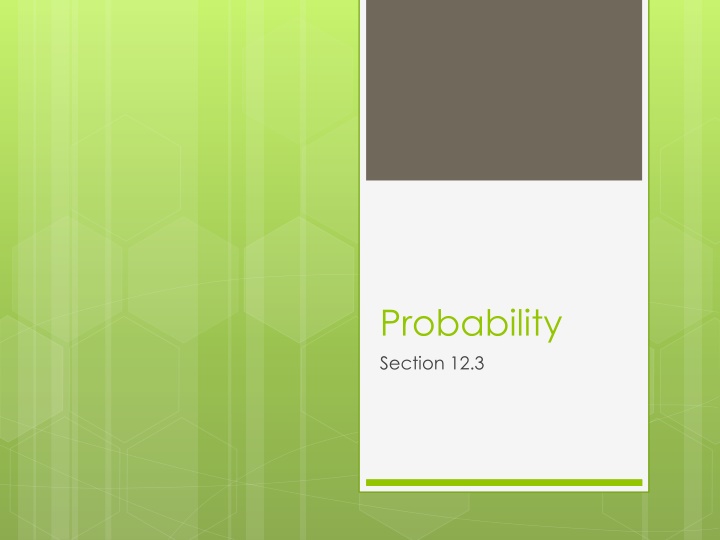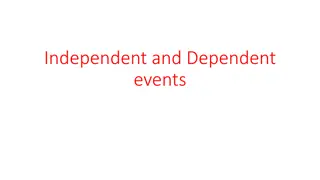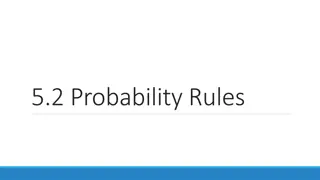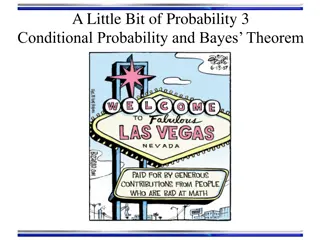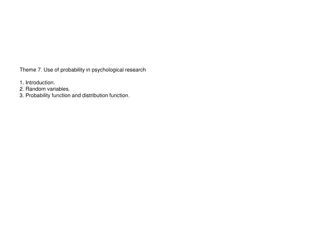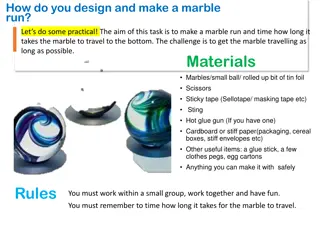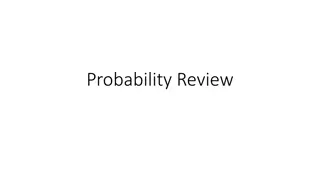Marble Probability
The concept of marble probability through visual aids and scenarios involving red and green marbles being removed from a set. Learn how to determine the probability of events like picking two red marbles or marbles of different colors.
Download Presentation

Please find below an Image/Link to download the presentation.
The content on the website is provided AS IS for your information and personal use only. It may not be sold, licensed, or shared on other websites without obtaining consent from the author.If you encounter any issues during the download, it is possible that the publisher has removed the file from their server.
You are allowed to download the files provided on this website for personal or commercial use, subject to the condition that they are used lawfully. All files are the property of their respective owners.
The content on the website is provided AS IS for your information and personal use only. It may not be sold, licensed, or shared on other websites without obtaining consent from the author.
E N D
Presentation Transcript
Probability Section 12.3
What is probability? Probability is the measure of how likely an event or outcome is. Different events have different probabilities!
How do we describe probability? You can describe the probability of an event with the following terms: certain (the event is definitely going to happen) likely (the event will probably happen, but not definitely) unlikely (the event will probably not happen, but it might) impossible (the event is definitely not going to happen) Can you think of examples of each type of event?
Probability Of an event is a number between 0 and 1 that indicates the likelihood the event will occur. If event certain to occur than prob=1 Event that cannot occur prob=0 Event equally likely to occur or not prob =
Theoretical Probability When all outcomes are equally likely, the theoretical probability that an event A will occur is: P(A)= ?????? ?? ???????? ?? ? ????? ?????? ?? ???????? Simply called probability of the event
How do we express probabilities? Usually, we express probabilities as fractions. The numerator is the number of ways the event can occur. The denominator is the number of possible events that could occur. Let s look at an example!
What is the probability the spinner will land on the number 3? 1 3 2 4
Ask yourself the following questions: 1. How many 3 s are on the spinner? 2. How many possible numbers could the spinner land on? 1 4 1 3 2 4
What is the probability the die will land on an even number? Remember, a die has six sides. Numbers 1, 2, 3, 4, 5, and 6 are each depicted once on the die.
What is the probability that I will choose a red marble? In this bag of marbles, there are: 3 red marbles 2 white marbles 1 purple marble 4 green marbles
You roll a six-sided die. Find probability of: A) rolling a four B) rolling an odd number C) rolling a number less than 7
Probability involving permutations or combinations You put a CD that has 8 songs in your CD player. You set the player to play the songs at random. The player plays all 8 songs without repeating any song. Find: A. what is the prob that the songs are played in the same order they are listed on the CD? B. You have 4 favorite songs on the CD. What is the prob that 2 of your favorite songs are played first, in any order?
Solution: A. There are 8! different perm of the 8 songs. Of these, only 1 is the order in which the songs listed on CD so P(playing 8 in order) = 1 8! = .0000248 B. There are C(8,2) different comb of 2 songs. Of these , C(4,2) contain 2 of your favorite songs. So P(playing 2 favs first)= ?(4,2) ?(8,2) = .214
Ex 2: There are 6 men and 3 women on city council. A committee of 2 is to be selected at random to study the city s plans for park expansion. What is the prob that the 2 selected are women? P(2 women)= ?(3,2) ?(9,2) = .083
Experimental Probability Sometimes not possible to find theoretical prob of an event. So we can perform an experiment, conduct a survey, or look at history of an event. For example, if a dice is rolled 6000 times and the number '5' occurs 990 times, then the experimental probability that '5' shows up on the dice is 990/6000 = 0.165.
If you toss a coin 10 times and record that the number of times the result was 8 heads, then the experimental probability was 8/10 or 4/5
Experimental Probability Formula Experimental Probability: P= Number of favorable outcomes Total number trials
Odds Another way to describe the chance of an event occurring is with odds. The odds in favor of an event is the ratio that compares the number of ways the event can occur to the number of ways the event cannot occur. We can determine odds using the following ratios: Odds in Favor = number of successes number of failures Odds against = number of failures number of successes
Example #3 Suppose we play a game with 2 number cubes. If the sum of the numbers rolled is 6 or less you win! If the sum of the numbers rolled is not 6 or less you lose In this situation we can express odds as follows: Odds in favor = Odds against = ` numbers rolled is 6 or less numbers rolled is not 6 or less numbers rolled is not 6 or less numbers rolled is 6 or less
Example #4 A bag contains 5 yellow marbles, 3 white marbles, and 1 black marble. What are the odds drawing a white marble from the bag? Odds in favor = number of white marbles number of non-white marbles Odds against = number of non-white marbles number of white marbles 3 6 6 3 Therefore, the odds for are 1:2 and the odds against are 2:1
Your Turn - Odds Find the favorable odds of choosing the indicated letter from a bag that contains the letters in the name of the given state. 1. S; Mississippi 2. N; Pennsylvania 3. A; Nebraska 4. G; Virginia
Your Turn Solutions 1. 4/7 2. 1/3 3. 1/3 4. 1/7
